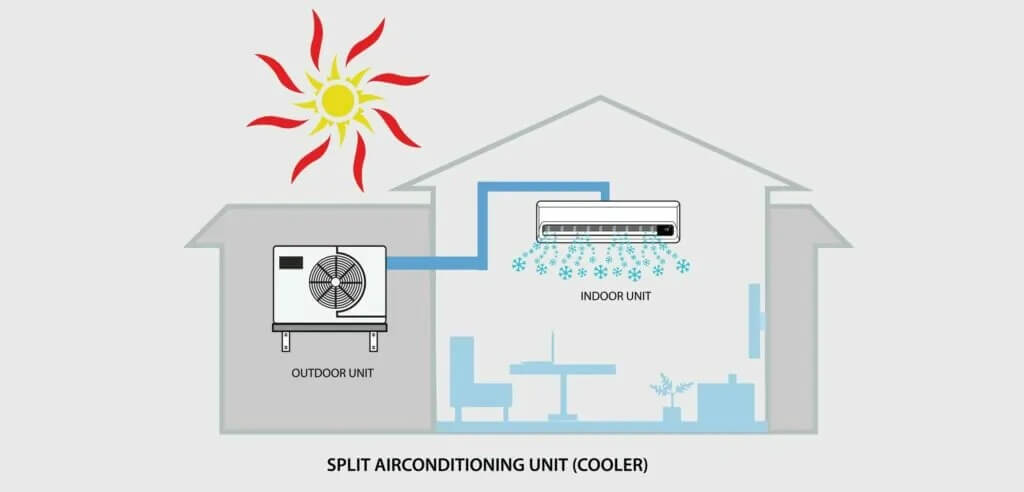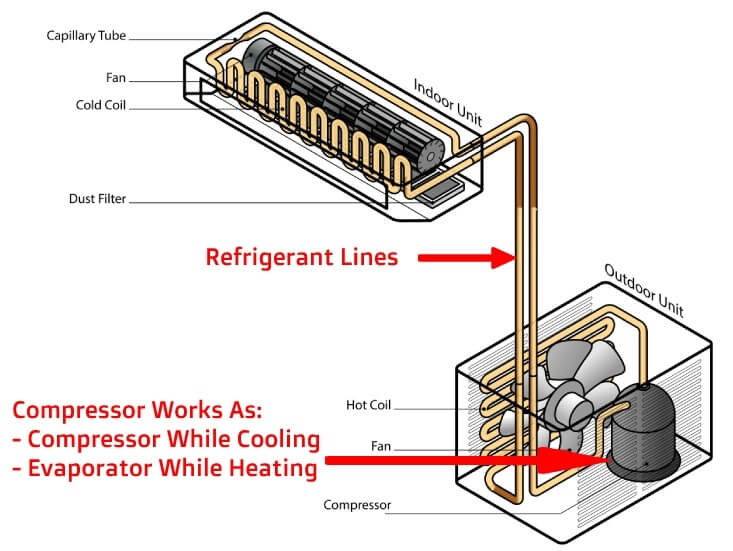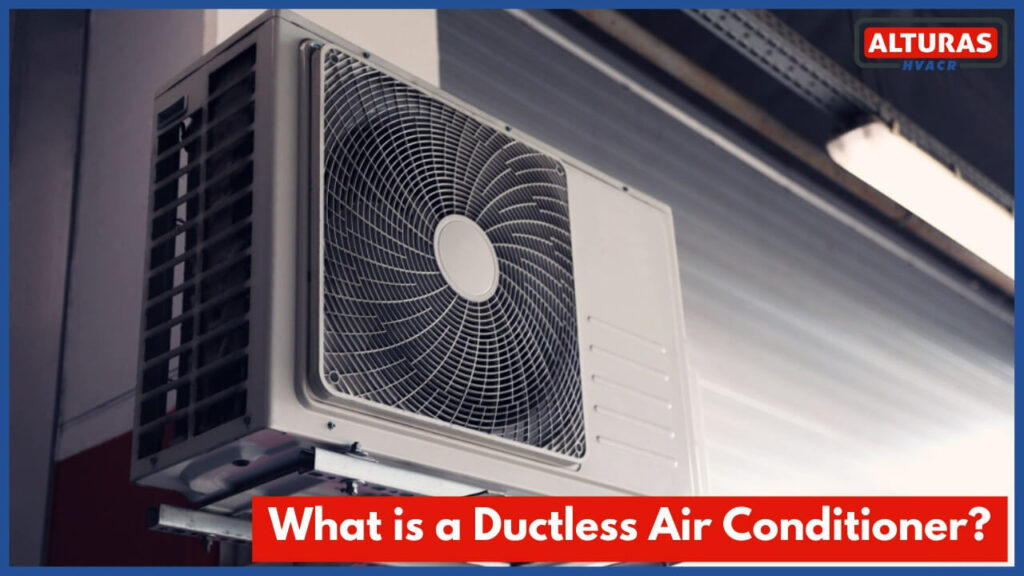You’ve heard the terms before ductless, mini-split, or mounted cooling systems. But have you ever wondered, “What is a ductless air conditioner?” In today’s world, where climate control is important for comfort and well-being, understanding innovative solutions like ductless air conditioners is becoming increasingly important.
This comprehensive guide will give details about ductless ac installation Los Angeles, answering all your burning questions and equipping you with the knowledge to make informed decisions about your home’s comfort needs.
What is a Ductless Air Conditioner?
A ductless air conditioner, also known as a mini-split system, is a revolutionary approach to climate control. Unlike traditional central air conditioning systems that rely on a network of ducts to distribute conditioned air throughout a house, ductless systems take a more localized approach.
Instead of ducts, mini-split systems consist of two main components:
- Indoor Units: These sleek, wall-mounted units are strategically placed in individual rooms or zones within your home. They house the evaporator coil, which absorbs heat from the indoor air, and a fan that circulates the cooled air throughout the designated space.
- Outdoor Unit: Located outside your home, this unit houses the compressor, condenser coil, and expansion valve. It works tirelessly to remove the extracted heat from the indoor air and expel it outdoors.
How Do Ductless Air Conditioners Work?

The magic of ductless air conditioners lies in their efficient refrigerant cycle. Here’s a simplified breakdown:
- Heat Absorption: The indoor unit’s evaporator coil, filled with a refrigerant, absorbs heat from the warm room air. This causes the refrigerant to convert from a liquid to a gas state.
- Heat Transfer: The refrigerant gas then travels through insulated copper piping to the outdoor unit.
- Heat Rejection: In the outdoor unit, the compressor pressurizes the refrigerant gas, raising its temperature. The hot refrigerant then passes through the condenser coil, where it releases the extracted heat to the outside air. A fan helps dissipate this heat further.
- Cooling Cycle Completion: Finally, the cooled refrigerant travels back to the indoor unit, where it expands through an expansion valve, dropping its temperature again. The chilled refrigerant then absorbs more heat from the indoor air, restarting the cycle.
What is Mini Split AC’s Zone? Single- and Multi-Zone Systems
Ductless air conditioners offer flexibility when it comes to controlling temperatures in specific areas of your home. Here’s a breakdown of the two main zone configurations:
- Single-Zone Systems: Ideal for cooling or heating a single room or a small designated area, single-zone systems feature one indoor unit connected to the outdoor unit. This is a perfect solution for rooms like sunrooms, garages, or basements that may not be adequately served by traditional central air conditioning.
- Multi-Zone Systems: For comprehensive comfort control throughout your home, multi-zone systems offer the ability to connect multiple indoor units to a single outdoor unit. This allows you to independently control the temperature in various zones, ensuring optimal comfort in each room.
What are the Pros and Cons of a Ductless Air Conditioner?

Pros of a Ductless Air Conditioner
There are numerous advantages to embracing ductless air conditioners for your home comfort needs. Here are some key benefits to consider:
- Energy Efficiency: Without the energy losses associated with leaky or poorly insulated ducts, ductless systems offer superior efficiency. This translates to lower energy bills and a reduced environmental footprint.
- Targeted Comfort: Unlike central air conditioning that cools your entire home, regardless of need, ductless systems allow you to cool or heat only the zones you’re occupying. This targeted approach saves energy and ensures you’re not wasting resources on unoccupied spaces.
- Easy Installation: Ductless systems require minimal installation compared to traditional systems. Since they don’t rely on extensive ductwork, AC installation is typically quicker and less disruptive to your home.
- Zone Control: As mentioned earlier, multi-zone systems offer the ultimate comfort by allowing you to set individual temperatures for different rooms. This is ideal for families with varying temperature preferences or homes with sunrooms or basements with specific climate needs.
- Quiet Operation: Ductless systems are known for their quiet operation. The outdoor unit is designed to minimize noise pollution, and the indoor units operate at whisper-quiet levels, ensuring a peaceful and comfortable environment.
- Space Saving: Since they don’t require bulky ductwork, ductless systems are a space-saving solution, especially for homes with limited ceiling space. The sleek, wall-mounted indoor units blend seamlessly into your existing décor.
- Year-Round Comfort: Many ductless systems offer not only cooling but also heating capabilities. This makes them a versatile solution for year-round comfort, eliminating the need for heating systems.
Cons of a Ductless Air Conditioner
While ductless air conditioners offer a lot of advantages, it’s important to consider all aspects before making a decision. Here’s a look at some potential drawbacks:
- Higher Initial Cost: Compared to traditional central air conditioning systems, ductless systems can have a higher upfront cost. However, the increased energy efficiency can lead to significant savings over time, potentially offsetting the initial investment.
- Limited Heating Capacity: While some ductless systems excel at heating, their capacity might be limited compared to traditional furnaces. This is particularly important to consider in colder climates where robust heating capabilities are crucial.
- Multiple Indoor Units: Depending on your cooling needs, a multi-zone system may require multiple indoor units. While these units are designed to be sleek, having several units on your walls might not be aesthetically pleasing for everyone.
- Professional Installation: While installation is generally simpler than traditional systems, ductless systems still require professional installation to ensure proper function and avoid future issues.
- Maintenance Needs: Like any mechanical system, ductless air conditioners require regular maintenance to maintain optimal efficiency and performance. This typically involves cleaning filters and scheduling professional check-ups.
Related: Why an Oversized Air Conditioner is a Serious Problem
Benefits of Ductless Air Conditioners
Having explored the pros and cons, let’s look at ome of the key benefits of ductless air conditioners and how they can enhance your home comfort:
- Improved Indoor Air Quality: Ductless systems often come equipped with advanced filtration systems that help remove dust, allergens, and other airborne irritants from the circulated air. This can be particularly beneficial for allergy sufferers or those seeking a cleaner and healthier indoor environment.
- Precise Temperature Control: With individual zone control, ductless systems allow you to set the perfect temperature in each room. This eliminates the frustration of feeling too hot or cold in certain areas of your home. Imagine enjoying a cool and refreshing bedroom while someone else enjoys a slightly warmer temperature in the living room – all controlled independently!
- Increased Home Value: Ductless air conditioning systems are becoming increasingly popular. As a result, installing a ductless system in your home can potentially boost its resale value by enhancing its comfort and energy efficiency.
- Extendable Comfort: The modular nature of multi-zone ductless systems allows for future expansion. If you decide to add a room or convert a space later, you can easily add additional indoor units to your existing system, extending its reach and maintaining consistent comfort throughout your evolving home.
Tips: Choosing the Right Ductless Air Conditioner for Your Needs
With the knowledge you’ve gained so far, you’re well on your way to making an informed decision about ductless air conditioners. Here are some expert tips to help you choose the right system for your home:
- Consider Your Needs: Evaluate your cooling and heating requirements. Do you need a system for a single room or your entire home? What climate do you live in?
- Measure Your Space: Knowing the square footage of the area(s) you want to cool or heat is crucial for determining the appropriate capacity of the ductless system.
- Consult a Professional: A qualified HVAC technician can assess your specific needs and recommend the most suitable ductless system for your home. They can also provide accurate estimates for installation and answer any questions you may have.
- Think Long-Term: Consider the long-term benefits of a ductless system, such as energy efficiency and potential resale value increase, when evaluating the initial cost.
By following these tips and leveraging the knowledge gained in this comprehensive guide, you can make a confident decision about ductless air conditioners and unlock a world of personalized comfort in your home. Remember, a well-chosen ductless system can not only enhance your comfort but also contribute to a more energy-efficient and environmentally friendly future.

